Introducing Spagetti™ Heavy 12wt Thread
Maura Kang
When your goal is to stand out, Spagetti™ knows how to be seen. This thick and juicy 12wt thread is actually the thickest thread you can safely fit through the eye of your machine needle. Some sewers love how boldly this thread stands out, while others might be a little intimidated by it. But we’re here to show you how to use this thread effectively to create color and texture you can’t ordinarily achieve with a regular thread.
Spagetti™ and its neighbour Fruitti™ are both 3ply, 12wt long staple Egyptian cotton threads that have been double gassed for a super low lint finish. Gassing is a term you may have come across in the sewing industry. It refers to a technique thread manufacturers use to burn off 80% of the lint from the surface of a thread. WonderFil actually repeats this process a second time, removing another 80% of the remaining 20% of the lint, resulting in an incredibly smooth, ultra low lint finish. If you take a close look at the thread, you’ll find very few fuzzies sticking out. This greatly reduces the lint build up in your machine, so you can spend more time sewing and less time cleaning it out, or fewer trips to the machine maintenance shop.
You can see in this side-by-side comparison how much thicker Spagetti™ looks beside a regular 50wt thread. While you wouldn’t use this thread for something like piecing, it’s the perfect choice for anything decorative that will show on top. Machine quilting with this thread will really make your quilting pop. And because the thread is so thick, it will completely change the look of your quilt top.
Or you can consider something like thread painting. Most sewers will use a 40wt thread to do this technique, but a 12wt thread sits a little higher on the fabric. You’ll be able to create a beautiful, raised texture simply by switching to this thread that can’t be achieved with thinner threads.
This thread is beautiful for any decorative top stitching, appliqué, or even sewing thicker materials like leather or upholstery, but what about for hand sewing? Big stitch hand quilting never looked better. It also makes for a beautiful sashiko thread, needle punch, or even for hand embroidering smaller details and designs. This 12wt thread is comparable in size to a single strand of embroidery floss.
There’s a lot of great techniques Spagetti™ can shine in, but we don’t recommend using it with itself in the bobbin. A thread this bulky in both the top and the bottom will likely cause a host of tension issues that will decrease your stitch quality.
So what should you use in the bobbin? Meet DecoBob™, an 80wt cottonized polyester. This little thread is incredibly small, but also surprisingly strong. While it’s important to use a fine bobbin thread in every application, it’s especially important when using a 12wt thread in the needle. This fine thread will greatly reduce tension problems because it always knows to give way to the top thread instead of fighting for tension in the machine. These two know how to work together for perfect, smooth stitching.
Of course, you’ll also need to choose a larger needle to accommodate this bulky thread. We recommend a 90/14 or 100/16 topstitch needle whenever using Spagetti™ because this needle has a larger eye. This gives the thread more room to move around and reduces the chance for the thread to shred or break.
Don’t be afraid to go bold with Spagetti™ and see how this thread can change the look of your projects! Inspired to sew with Spagetti™ and Fruitti™? Head on over to shopwonderfil.com/shop-local/ for a list of stores and retailers you can purchase from.


















